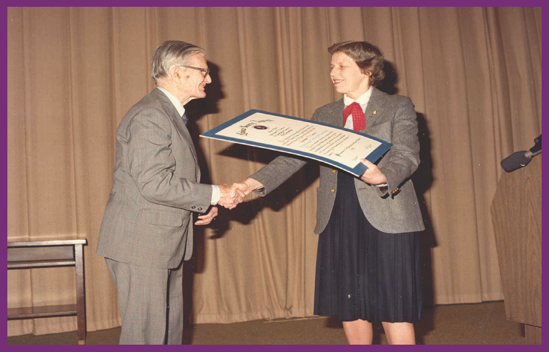The volume at hand, Dr. George F. Howe's American Signals Intelligence in Northwest Africa and Western Europe is important professional reading for those interested in cryptologic history or in World War II.
The first historian for the National Security Agency was Captain Thomas Dyer, USN, who had made significant contributions in cryptanalysis during the war. When Dyer retired in 1954, NSA decided to hire a professional historian as his replacement. That was Dr. George F. Howe.
Dr. Howe was born in Vermont in 1901, and received his Ph.D. from Harvard in 1926. He was a professor of history at the University of Cincinnati for the next two decades. In 1945 he joined the research and writing staff of the Army's Historical Division. While in that position, he wrote Northwest Africa: Seizing the Initiative in the West, published in 1957 as part of the official series on World War II, commonly known to historians as the "Army's green books."
At NSA Dr. Howe supervised a small staff in preparing a number of specialized histories as well as a general study of the Armed Forces Security Agency, NSA's predecessor. Dr. Howe retired in 1971, although he was called back to assist part-time with several history projects. He passed away in 1988.
It is fitting that, for his own major project at NSA, Dr. Howe chose to write about signals intelligence support in North Africa (and Western Europe), drawing on the expertise developed for the "green books" and adding to it a dimension he could not write about for unclassified publication in the 1950s.
Dr. Howe's book deals primarily with organizational matters for providing SIGINT support in combat. Thus, the reader will not find stories of high-level cryptanalysis underlying big decisions by famous leaders. In my estimation, by concentrating on the less flashy aspects of wartime support in favor of the background work, Dr. Howe has again added a dimension of great worth to our knowledge of SIGINT and of the war.
The study of World War II SIGINT has concentrated, by and large, on ULTRA, the exploitation of high-grade cryptographic systems used by Germany and Japan, and the use of ULTRA material by senior wartime decision makers. This effort unquestionably is important for understanding the decisions and events of that terrible era, but the overwhelming focus on this aspect has resulted in a slightly skewed understanding.
The production of ULTRA and its effective use depended on a strong and well-organized structure working in conjunction with now-legendary cryptanalysts. Since the distribution of ULTRA was limited to a small number of officers and civilian leaders, the bulk of SIGINT support to the war-fighter came from tactical SIGINT units working at or near the front lines.
Dr. Howe has restored to us essential details about the organization, maintenance, deployment, and service of the military cryptologic units that undergirded the ULTRA effort and supported combat forces directly.
This is an important subject for understanding what happened in World War II and for studying the principles of SIGINT organization today.
Dr. Howe's book was released in part in the late 1980s as a "Special Research History," an early NSA method of declassifying documents and studies. That was a time when much of the SIGINT story, even from World War II, was still classified; thus, significant portions were blanked out. It is a pleasure now to be able to present an unexpurgated version of this fine history.
David A. Hatch
NSA Historian 2010

Dr. Howe receiving an award in 1982 from Ms. Ann Caracristi, then the deputy director of NSA
